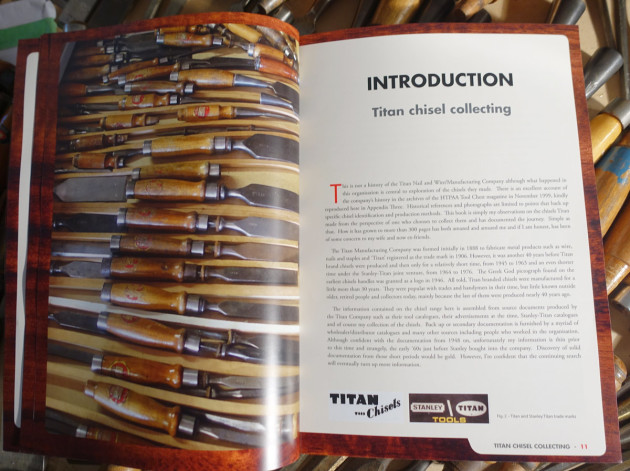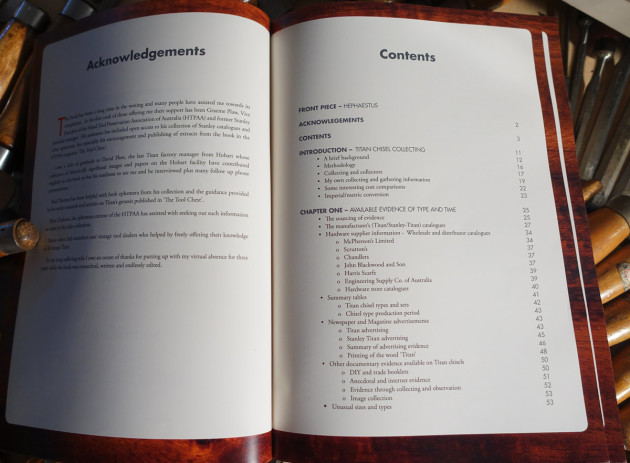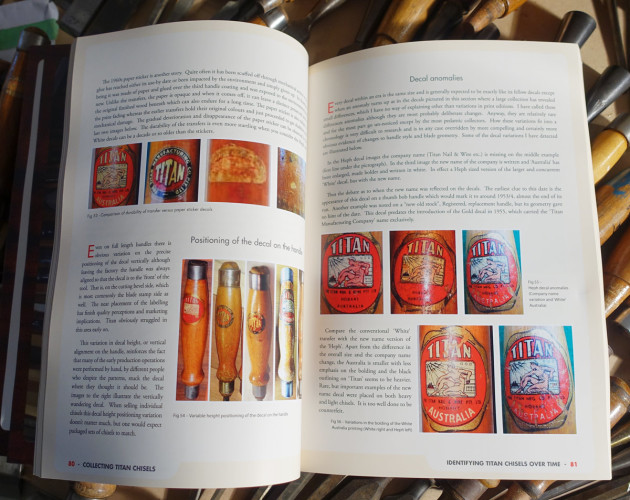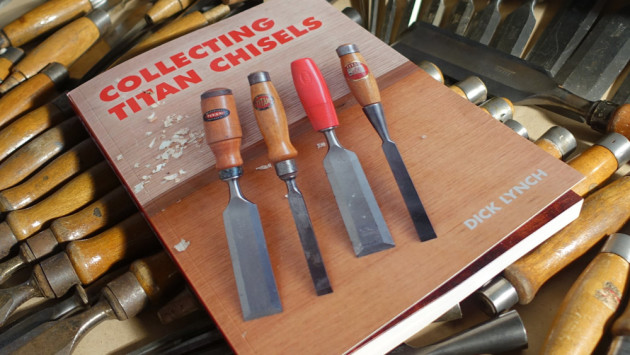Collecting Titan Chisels
Collecting Titan Chisels
Author: Richard Lynch
Merton: RL Media Pty Ltd
ISBN 9780994443601
Reviewed by Robert Howard
The first question many readers will ask is why on earth would anyone want to collect Titan chisels, much less write, and self-publish, a book about it? Furthermore, how could you possibly have enough to say to fill 320 pages?
Dick Lynch’s reasons are partly historical (the first chisels he owned as a young apprentice were Titans), partly psychological (as anyone who has the collecting gene will recognise), and partly unknown, even to him, as he happily admits. But there is also a more general requirement that needs to be met for any object to become collectible, particularly if, like most of us, you do not have very deep pockets, and that is availability. The object you decide to collect needs to have been once produced in great numbers, at modest cost, and with some variety, so that there will be sufficient examples readily available to keep you interested. Titan chisels fit these requirements.

As for the psychological reasons, I must quote Dick as he writes about his collecting in terms that many readers will recognise: ‘A lot of the collectors are ex-tradesman and their skills and the love of tools never leaves them. Related to this, is the hunting/gathering involved. This is an almost spiritual, and always a pleasurable, pursuit usually conducted in amenable surroundings (tools and blokes) in very agreeable places such as swap meets, trash and treasure markets and tool sales with the added bonus of the prospect of combining a special find with some captivating chat. Usually following the pick is the pleasure of a few hours in the workshop (or the more modern ‘man-cave’) restoring an old tool to near its previous glory’. That sounds pretty healthy to me although he cheerfully acknowledges that it does require ‘a touch of quixotic insanity that keeps the quest focussed on the unreachable horizon of “collecting all of them”’.

Titan chisels were made in Tasmania from 1945 to 1963, and, as Stanley-Titan, from 1964 to 1976, because of a shortage of imported tools immediately following the Second World War. The building boom of the 50s and 60s, fuelled by rapid population growth, required a large workforce of carpenters and allied trades, and these workers needed tools. Millions of Titan chisels were produced, with the aid of tax breaks, and sold behind tariff barriers, until the 1970s, when our high wage structure and rising costs of inputs made local manufacturing uneconomic. Though not made for 40 years, almost any market or swap meet today would produce numerous examples of the many different Titans produced, though collectible examples are becoming increasingly rare.
If, like Dick, you were to decide to collect Titans, you would quickly find yourself with a number of challenges focusing on dating, appearance and changes that have occurred. In other words, you would need to know what you are looking for, or at, and if that information was not readily available, you would have to discover it for yourself.

Thanks to Dick Lynch, for Titan chisels, that work has been largely done, though it will never be finished. In his words ‘Over a protracted period I have hunted, gathered, sifted, recorded and filed every last piece of Titan chisel information I can get my hands on…These are all filed under various headings and I record all pertinent details such as handle type/shape, tang and collar design, dome and ferrule placement and associated blade markings and decals etc’.
This information is important when you want to assess the authenticity of any find, and to date it. As with any old tool, mismatched blades and handles are common, and outright fakes not unheard of. Detailed knowledge of the Titan range, and the way handles, decals, and blade marks have changed over time allow you to sort the good from the bad, to spot the special finds, to know when a tool is worth buying for its handle, or its blade, and what a fair price might be.
All this information, and much more, is now available to us in this valuable book. It is a fascinating read even if you never intend to become a collector, although you will never look at a Titan chisel in the same way after reading it, and that might be enough to begin a serious obsession. I didn’t know, for example, that the ‘wooden’ handles (the ones without the top steel hoop) were made from Tasmanian myrtle, or myrtle beech (Nothofagus cunninghamii), whereas the rest were Tasmanian blue gum (Eucalyptus globulus), or that the early chisel handles were a copy of the Swedish Berg design.
Numerous photos show how details have changed over time. There are also many tables collating all the details for easier understanding and memorising. Of course, any book like this is necessarily incomplete, as the search for historical details goes on, and I am sure Dick would also readily acknowledge there is ample room for corrections to be made as more details are discovered and pooled. But what a beginning this book represents. If you are, like me, an avid collector of woodworking information, I am sure this book deserves a place in your bookcase. If you wish to take the extra step and begin a collection, the book is indispensable.
For more information or to purchase the book email info@lynch.com.au
Robert Howard is a woodworker and sculptor who lives in Brisbane. He teaches regular woodwork classes from his studio. Email: howardrobert@me.com



